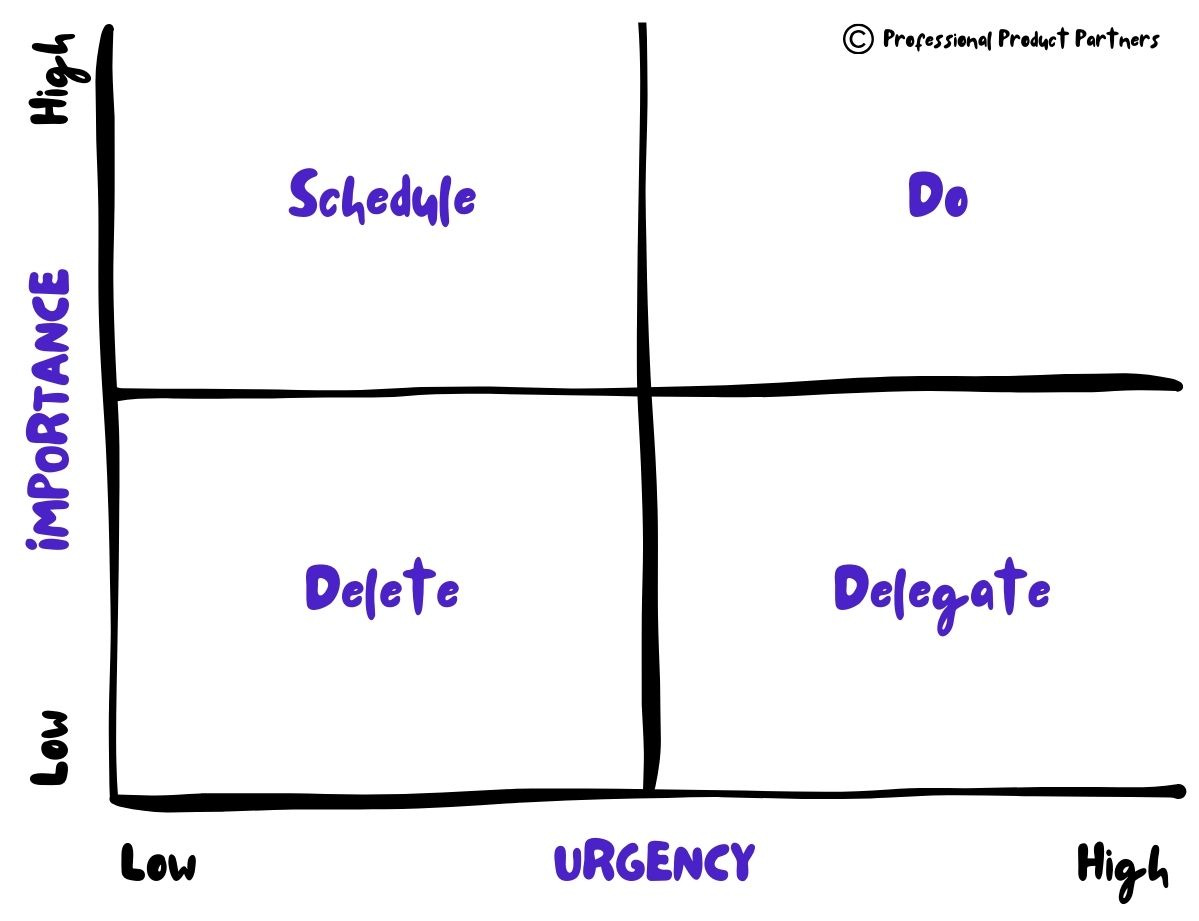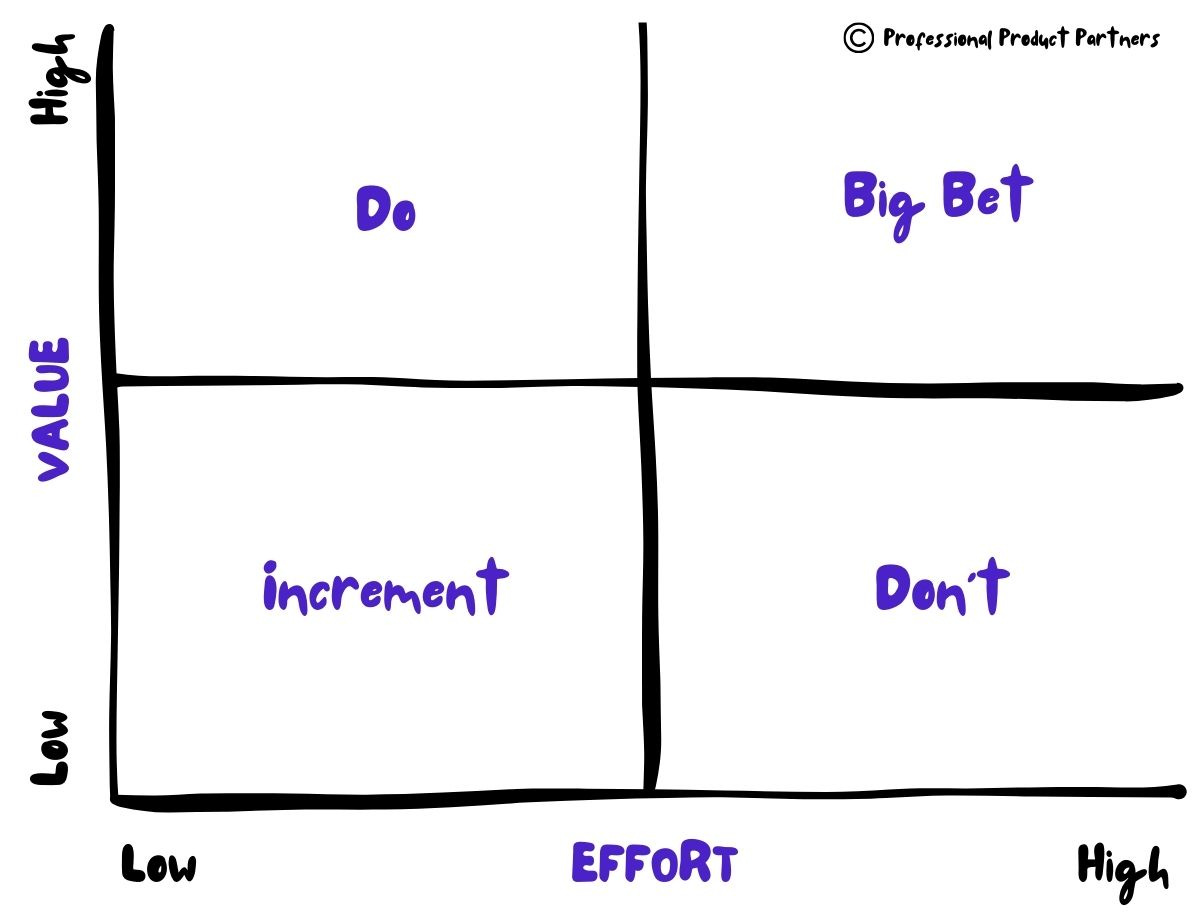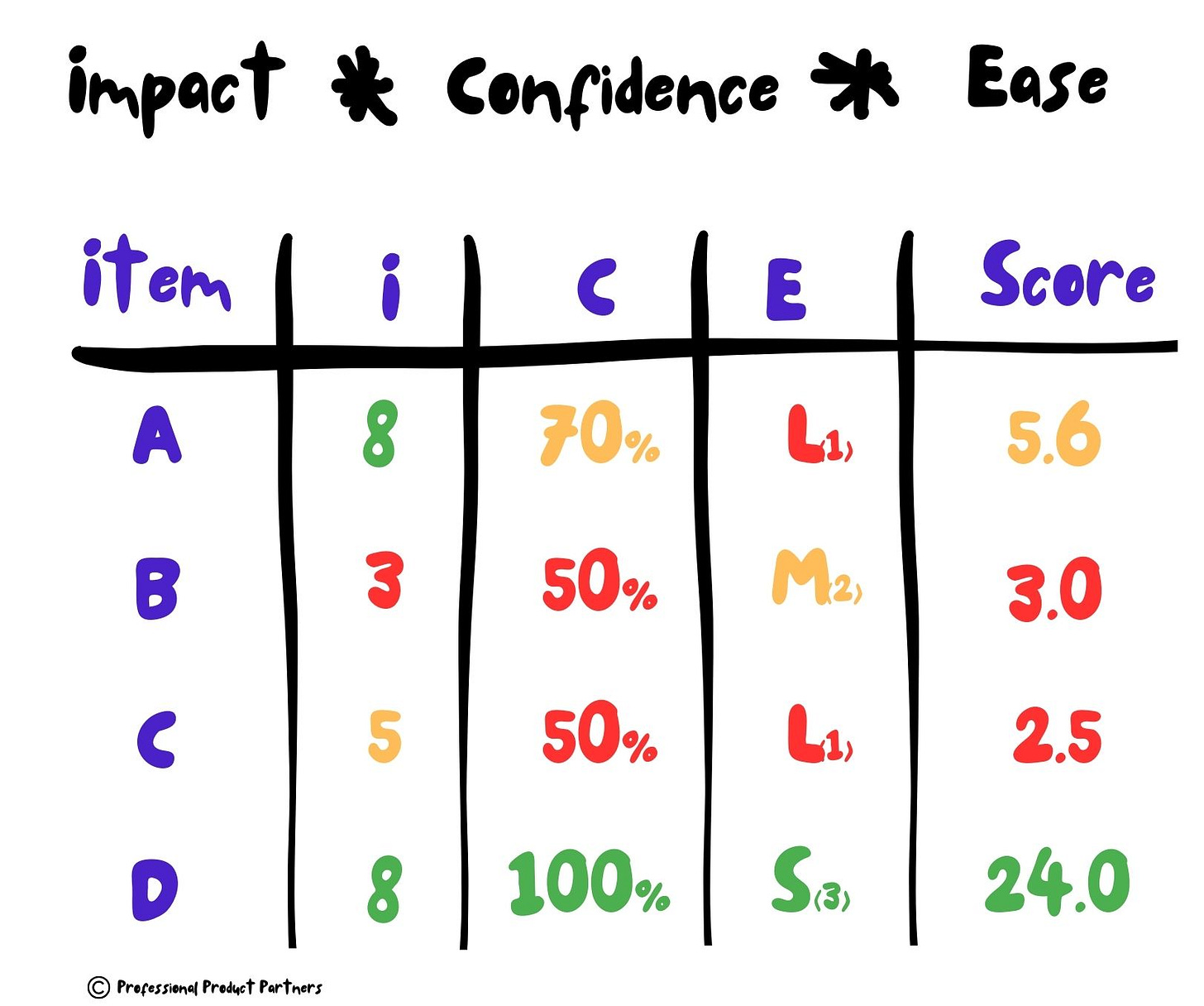The Art of Prioritization
4 simple step-by-step guides to popular prioritization methods
Introduction
Throughout my career, I have been constantly bombarded with a load of opinions, tasks, ideas, and projects that require my attention. I am not alone; most product managers feel this way. Discovering the next big thing, building new features, or ensuring what we have shipped in the past is adopted, our to-do list can seem never-ending. To avoid losing our minds and drowning in an endless sea of “URGENT!!” tasks, it is absolutely crucial to master the art of prioritization. This blog post aims to answer the question of which prioritization methods are out there and provides a practical step-by-step guide for each one of them.
Let's look at 4 step-by-step guides to prioritization frameworks that should give you a good repertoire to prioritize almost anything:
1. The MoSCoW Method: Setting Priorities with Musts, Shoulds, Coulds, and Won'ts
The simplest yet very effective prioritization method is called the MoSCoW method. It's not related to a large city in Russia but rather an acronym for 4 statuses of a one-dimensional prioritization framework. These 4 statuses are MUST HAVE, SHOULD HAVE, COULD HAVE, and WON’T HAVE. Let's dive into how one can best use the MoSCoW method.
MoSCoW step-by-step guide
Step 1: Create a list of all your tasks, projects, feature requests, bugs, or whatever else needs to be prioritized. Write down everything; don’t leave anything out.
Step 2: Search for all the tasks that have to be done, no questions asked, non-negotiable. The whole project falls apart if these are not done. These have to be absolutely critical for the success of what you are currently prioritizing. Assign MUST HAVE
Step 3: Now for the ones remaining, search for the items that are very important, the ones you wanted to mark with MUST HAVE but you weren’t able to justify doing that. Don’t mark any nice-to-haves but things that are necessary at one point. Assign SHOULD HAVE.
Step 4: As a next step, skip the COULD HAVES for now and directly go for all the ones that are simply not worth the effort. Where is it clear that the impact is not comparable to the effort you or your team have to put in? Mark them with WON’T HAVE.
Step 5: As a last step, assign the remaining ones with COULD HAVE.
Congratulations, you have successfully prioritized something with the MoSCoW method. And even though it seems simple, it can already have a huge impact. Find a Google Sheets template you can use for the MoSCoW method here: https://www.pp.partners/templates-downloads/moscow-prioritization-template
2. The Eisenhower Matrix: Sorting Tasks Based on Urgency and Importance
Next up is the Eisenhower Matrix. The concept was popularized by former US president Dwight D. Eisenhower who used it himself to prioritize high stake tasks based on two axes: Importance and Urgency.
Once the items are scored on both axes, the idea is to visualize them on a grid which can then be divided into 4 quadrants:
Urgent and Important items. → DO (The stuff that should get your immediate attention).
Urgent and Not important items. → DELEGATE (Things that need to get done but might not have enough impact to get your focus).
Non-urgent and Important items. → SCHEDULE (Stuff you should put on your to-do list, so you get to them eventually).
Non-urgent and Non-important items. → DELETE (Stuff you should simply delete from your list, not worth even thinking about it).
Again let’s have a look at a step-by-step guide on how to effectively use the Eisenhower Matrix for prioritization.
Eisenhower Matrix step-by-step guide
Step 1: Define the scale for both urgency & importance.
Step 1.1 URGENCY: If not using numbers right away, assign a numeric value to all options. I personally like leaving the middle number out to force myself to make a decision in either direction. An example could be
5: Very urgent - needs to be done today
4: Urgent - needs to be done this week
2: Not urgent - needs to be done this month
1: No deadline - can be done anytime
Step 1.2 IMPORTANCE: I personally like assessing importance by understanding how bad it would be if I simply would not complete the item at all. An example could be:
5: Very important - has a detrimental impact if not done.
4: Important - would have a significant impact if not done.
2: Not very important - has little impact if not done.
1: Not important - has almost no impact if not done.
Step 2: Create a list of all your tasks, projects, feature requests, bugs, or whatever else needs to be prioritized.
Step 3: Create 2 columns to score the two mentioned factors: Importance & Urgency
Step 4: Assign one of these values for both urgency as well as importance.
Step 5: Plot your results on a two-dimensional grid.
Step 6: Identify in which of the 4 quadrants an item ends up and act accordingly.
Congratulations, you have successfully prioritized something with the Eisenhower Matrix. Find a Google Sheets template you can use for the Eisenhower Matrix here: https://www.pp.partners/templates-downloads/eisenhower-matrix-prioritization-template
3. The Value vs. Effort Matrix: Balancing Impact and Feasibility
Now let's look at the Value/Effort Matrix. Compared to the first two, we are now also factoring in how complicated an item is to complete: effort. This makes the value vs. effort matrix very useful to use when assessing tasks with varying effort, for example, feature requests. Secondly, we want to score the "value" of the item, this can be a defined scale or a subjective understanding of value, both have upsides and downsides. Once the items are scored on both axes, the idea is to visualize them on a grid which can then be divided into 4 quadrants:
High value and High effort items. → BIG BET (Things that could pay off but has the risk to take a lot of work, for these very carefully consider if you should spend the time).
High value and Low effort items. → DO (These are quick wins and should be tackled immediately).
Low value and High effort items. → DON'T (This would be a waste of your time, disregard these items immediately in most cases).
Low value and Low effort items. → INCREMENT (Items in this quadrant are improvements to the status quo, they won't move the needle by much but come cheap).
Again let’s have a look at a step-by-step guide on how to effectively use the Value vs. Effort Matrix for prioritization.
Value vs. Effort Matrix step-by-step guide
Step 1: Define the scale for both value & effort.
Step 1.1 VALUE: If not using numbers right away, assign a numeric value to all options. I usually create an easy-to-score written system based on the metric I need to improve. An example using ARR could be:
5: Very high value - Potentially increases ARR by >€1m
4: High value - Potentially increases ARR by >€500k
3: Medium value - Potentially increases ARR by >€250k
2: Low value - Potentially increases ARR by >100k
1: No value - Unclear how it would increase ARR
Step 1.2 EFFORT: Yet again either directly assign a numeric value or create a system that explains what the numbers mean. Example:
(5)XL: Very high effort - >12 weeks implementation time.
(4)L: High effort - 6-12 weeks implementation time.
(3)M: Medium effort - 2-6 weeks implementation time.
(2)S: Low effort - 1-2 weeks implementation time.
(1)XS: Low effort - <1 week implementation time.
Step 2: Create a list of all your tasks, projects, feature requests, bugs, or whatever else needs to be prioritized.
Step 3: Create 2 columns to score the two mentioned factors: Value & Effort
Step 4: Assign one of these values for both Value & Effort.
Step 5: Plot your results on a two-dimensional grid.
Step 6: Identify in which of the 4 quadrants an item ends up and act accordingly. Congratulations, you have successfully prioritized something with the Value vs. Effort Matrix. Find a Google Sheets template you can use for the Value vs. Effort Matrix here: https://www.pp.partners/templates-downloads/value-vs-effort-matrix-prioritization-template
4. The ICE Scoring Method: A Data-Driven Approach to Prioritization
Last but not least comes the ICE Scoring method for prioritization. ICE brings in a more mathematical approach to prioritization as the outcome is a clear score. To score something with ICE one needs to score on 3 dimensions this time: IMPACT, CONFIDENCE & EASE. Once all are scored, Impact, Confidence & Ease are multiplied and a score is computed. Finally, sorting by the score gives a very simple way to understand where to put priority and where not.
Again let’s have a look at a step-by-step guide on how to effectively use ICE for prioritization.
Step 1: Define the scale for all three factors. (Impact, Confidence, Ease)
Step 1.1: IMPACT: Impact describes what the value of the item would be if completed. (You can always assess this by the damage if not delivered) This could be an arbitrary scale from 1-10 or what I usually do is creating an easy-to-score written system based on the metric I need to improve. Similarly to value in the value vs. effort matrix, an example using ARR could be:
5: Very high value - Potentially increases ARR by >€1m
4: High value - Potentially increases ARR by >€500k
3: Medium value - Potentially increases ARR by >€250k
2: Low value - Potentially increases ARR by >100k
1: No value - Unclear how it would increase ARR
Step 1.2: CONFIDENCE: Confidence describes how well do you know that the impact you have assigned will be reached. Sometimes one comes along to "moonshot" ideas with crazy impact but it might as well just not have this impact depending on various factors. I usually score confidence like this:
50% (0.5): Low confidence - There is no evidence that the impact will be achieved
70% (0.7): Medium confidence - There is some evidence that the impact will be achieved (e.g. Conversations with customers, etc.)
100% (1): High confidence - There is hard data that the impact will be achieved
Step 1.3: EASE: Ease is essentially an inverse of Effort. (How easy is it to build this) If it is not clear how much effort something will be it can also be conceptual complexity that is assessed, meaning the difference between having to change the behavior in a market vs. an incremental change to a feature that is already used. An example would be:
XL: Very high effort - >12 weeks implementation time.
L: High effort - 6-12 weeks implementation time.
M: Medium effort - 2-6 weeks implementation time.
S: Low effort - <2 weeks implementation time.
Step 2: Create a list of all your tasks, projects, feature requests, bugs, or whatever else needs to be prioritized.
Step 3: Create 3 columns to score the three mentioned factors: Impact, Confidence & Ease
Step 4: Assign one of the defined values for impact, confidence & ease to all of your items.
Step 5: Compute an ICE score by multiplying all three factors. Congratulations, you have successfully prioritized something with the Value vs. Effort Matrix. Find a Google Sheets template you can use for the ICE prioritization method here: https://www.pp.partners/templates-downloads/ice-prioritization-template
When to use which method ?
MoSCoW: This can be used for almost anything you like prioritized, from feature requests to vacation destinations. It is quite simple and should be a go-to when you want to quickly prioritize or communicate priorities to others.
Eisenhower Matrix: The Eisenhower matrix works especially well when time is an important factor in what you are prioritizing. For that reason, I like to use it for daily to-dos as it helps to understand where to focus and which things to leave for now or forever.
Value vs. effort matrix: As this method has an emphasis on both understanding the value of items as well as the investment needed (effort), this works particularly well for software projects. Assessing features & bugs like this is a perfect fit.
ICE: ICE works similarly well for software projects as the value vs. effort matrix does, but it adds confidence to the equation which I particularly like as it shows where more research is needed before something can be prioritized.
Conclusion
In conclusion, mastering the art of prioritization is crucial for product managers. We explored four popular prioritization frameworks: the MoSCoW Method, the Eisenhower Matrix, the Value vs. Effort Matrix, and the ICE Scoring Method. Each method offers a unique approach to prioritizing tasks based on different factors such as importance, urgency, impact, and feasibility. By understanding these frameworks and applying them to your own projects, you can make informed decisions and effectively manage your workload. Remember, the choice of prioritization method depends on the specific context and requirements of your tasks and goals. Experiment with different methods and find the one that works best for you and your team. Happy prioritizing!






